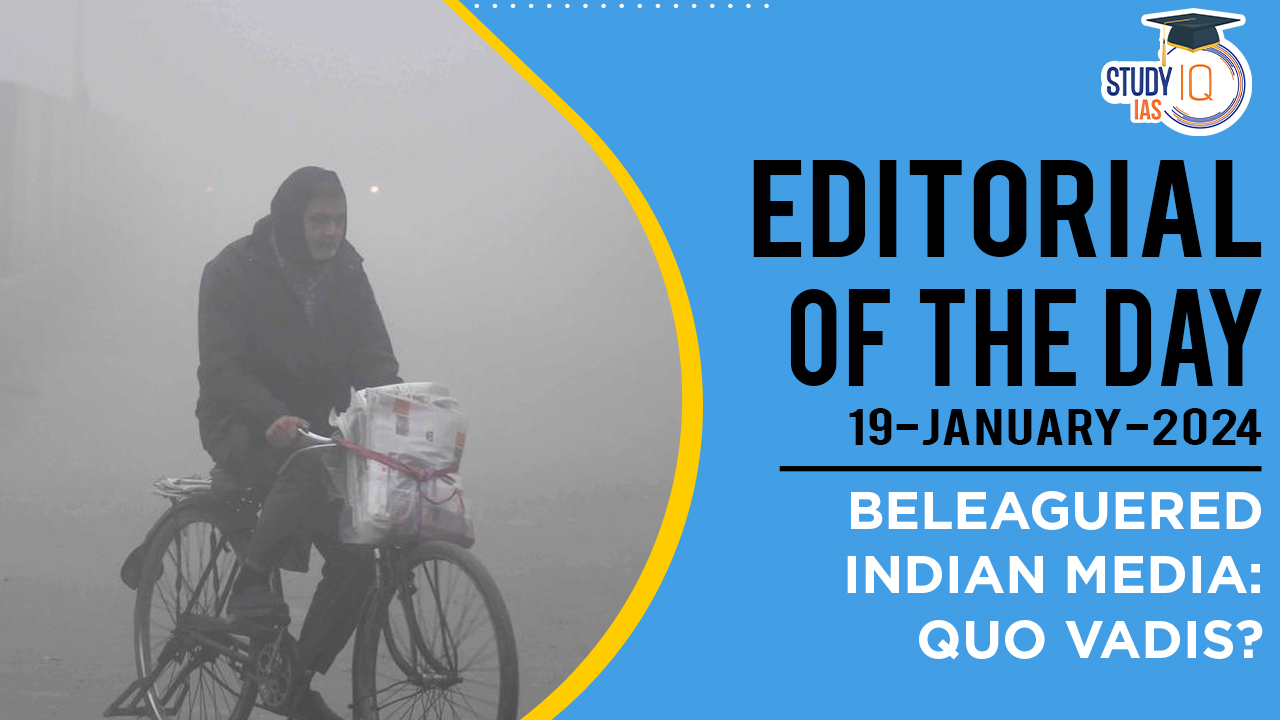Table of Contents
Context: Since liberalisation in 1991, media having slipped from its true place in a democracy is a serious concern.
Challenges Faced By Indian Media
- Shift to “Breaking News” Culture: The media, especially television news, is now predominantly driven by the urgency to break news, often at the cost of quality and depth. This has led to sensationalism over substantive reporting.
- Dilution of Public Service Role: There’s a noticeable shift away from the traditional role of media as a public service provider. The focus has shifted to gaining ratings and viewership through sensational stories.
- Trial by Media: The media often acts as witness, prosecutor, judge, jury, and executioner. This is akin to a modern-day “agnipariksha” or trial by fire, where individuals are judged and condemned by media narratives rather than evidence or fair trial.
- Impact of Social Media: The rise of social media has introduced unverified facts and viral opinions into the mainstream. Content that would typically fail editorial scrutiny now finds a platform, further blurring the lines between fact and opinion.
- Compromised Print Media: Traditionally seen as a more reliable and in-depth medium, print media is also succumbing to the pressures of the 24×7 news cycle and the influence of social media. This often leads to publishing without adequate fact-checking.
- Rush to Judgment and Lack of Critical Analysis: Media often broadcasts charges and allegations uncritically, without basic questioning of their plausibility. This can lead to irreversible damage to people’s reputations.
- Blurring of Key Distinctions: The critical distinctions between fact, opinion, speculation, reportage, rumour, sourced information, and unfounded allegation are becoming increasingly blurred in Indian media.
- Trivialisation of Public Discourse: The media’s focus on superficial and sensational stories trivialises important public discussions and abandons its responsibility as a watchdog in a democracy.
- Weapon of Mass Distraction: The sensational approach of the media serves to distract the public from more pressing issues of governance and accountability.
- Threats to Free Press: Despite the value of a free press, there are concerns about government intimidation, the blocking of TV channels, and the arrest of journalists, which threaten media freedom.
- Need for Better Journalism, Not Censorship: The demand is not for censorship or reduced journalism, but for improved quality and responsible journalism that serves the democratic process and public interest effectively.
We’re now on WhatsApp. Click to Join
Suggestive Measures
- Encourage Fact-Verification and Accuracy: There needs to be a culture shift in the industry where journalists are not pressured to break news prematurely but are encouraged to verify facts and accuracy before publishing. This would help in reducing the rush to judgement based on partial information.
- Improved Journalistic Training: There’s a call for better training at accredited media institutes that focus on teaching values of accuracy, integrity, and fairness. Additionally, media organisations should be held accountable for publishing false claims or misleading statements by issuing retractions with equal prominence.
- Diversity in Newsrooms: Emphasising the importance of different perspectives in newsrooms to prevent them from becoming echo chambers. News stories should be balanced by providing space for alternative views or refutations, ensuring a more diverse journalistic environment.
- Encourage Public Engagement: Journalists should actively welcome comments and feedback from their audience. This not only fosters trust between the media and its consumers but also makes the public feel like active participants rather than passive recipients. The example of The Hindu having a Readers’ Editor is cited as a positive practice.
- Regulations on Media Ownership: The government should introduce laws to limit the control of multiple news organisations by a single business or political entity. This is to prevent powerful business interests, which may be susceptible to government pressure, from compromising ethical journalistic standards.
- Unified Oversight for Media: The recommendation is for a single overseer for both print and television news companies. This would help limit the influence of corporate and political giants over the media and promote higher media standards. This recommendation was supported by the Telecom Regulatory Authority of India and the parliamentary Committee on Information Technology.


 SEBI’s SWAGAT-FI Framework for Low-Ris...
SEBI’s SWAGAT-FI Framework for Low-Ris...
 How the US and China Are Sabotaging the ...
How the US and China Are Sabotaging the ...
 Village Defence Guards (VDGs): Role, Str...
Village Defence Guards (VDGs): Role, Str...

























